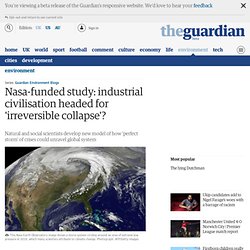

Theconversation. What if carbon trading – where companies must bid for limited permits to emit pollutants, and so pay a price in order to do so – could be applied on an individual level?

Personal carbon trading is a policy idea that aims to reduce a nation’s overall carbon emissions by handing to individuals rights and responsibilities for their own emissions. With the IPCC this week preparing their latest report on the threat of climate change, with greenhouse gas emissions still rising perhaps it’s time to put more tools on the table. In a scheme designed to manage household energy use and personal travel, each adult would be allocated an equal annual carbon allowance. Units of this carbon allowance would have to be paid out when paying household energy bills or filling up the car. Those using less than their annual allowance could sell their surplus units, while those needing more would have to buy them.
The UK government has set itself a target of reducing carbon emissions by 80% by 2050. Redistribution, inequality and growth. La redistribution n’est plus un gros mot pour les experts du FMI. Une nouvelle note du FMI vient écorner les dogmes de l’institution.

Deux experts ont livré mercredi un plaidoyer en faveur de la lutte contre les inégalités et de la redistribution des richesses. Indispensables pour une croissance durable. Que dit la note ? L’augmentation des inégalités de revenus «est une menace pour la gouvernance démocratique». Et une croissance «plus rapide et plus durable semble avoir suivi la réduction des inégalités», écrivent Jonathan Ostry et Andrew Berg, directeur et directeur adjoint du département de la recherche du FMI.
Quelles conséquences ? «Dans les années qui viennent, il ne sera plus possible de simplement se focaliser sur la croissance. Christian LOSSON. Nasa-funded study: industrial civilisation headed for 'irreversible collapse'? A new study partly-sponsored by Nasa's Goddard Space Flight Center has highlighted the prospect that global industrial civilisation could collapse in coming decades due to unsustainable resource exploitation and increasingly unequal wealth distribution.

Noting that warnings of 'collapse' are often seen to be fringe or controversial, the study attempts to make sense of compelling historical data showing that "the process of rise-and-collapse is actually a recurrent cycle found throughout history. " Cases of severe civilisational disruption due to "precipitous collapse - often lasting centuries - have been quite common. " The independent research project is based on a new cross-disciplinary 'Human And Nature DYnamical' (HANDY) model, led by applied mathematician Safa Motesharrei of the US National Science Foundation-supported National Socio-Environmental Synthesis Center, in association with a team of natural and social scientists. Modeling Inequality and Use of Resources in the collapse or sustainability of societies. The Collapse of Western Civilization: A View from the Future. Nasa-funded study: industrial civilisation headed for 'irreversible collapse'?
A new study partly-sponsored by Nasa's Goddard Space Flight Center has highlighted the prospect that global industrial civilisation could collapse in coming decades due to unsustainable resource exploitation and increasingly unequal wealth distribution.

Noting that warnings of 'collapse' are often seen to be fringe or controversial, the study attempts to make sense of compelling historical data showing that "the process of rise-and-collapse is actually a recurrent cycle found throughout history. " Cases of severe civilisational disruption due to "precipitous collapse - often lasting centuries - have been quite common. " The independent research project is based on a new cross-disciplinary 'Human And Nature DYnamical' (HANDY) model, led by applied mathematician Safa Motesharrei of the US National Science Foundation-supported National Socio-Environmental Synthesis Center, in association with a team of natural and social scientists. The Well-Intentioned, Misguided Eco-Doomers - Collide-a-Scape.
If you are a regular consumer of environmental news and commentary, you are familiar with the narrative of humanity’s downfall.

The story, we are told, looks like this. If we continue to ignore the danger signs while exceeding the planet’s carrying capacity, the future may get ugly. For the time being, we are on a precipice. Although our thought leaders and scholars have been giving us ample warning, we don’t seem to be paying attention. Maybe they should listen to the words of Jenny Price and try a new tack. But that may be asking too much. I must admit that I find the collapse junkies entertaining. Others who drink too much from the ecocide well may sink into a fatalistic state of despair: Every time I read the NBL [Nature Bats Last] posts, I get the feeling that there´s nothing to be done with our lives, and our future.
A widely circulated piece from the New York Times recently advised: Take industrial agriculture, for example. These are not trivial questions.